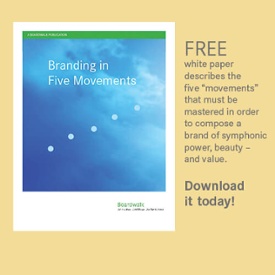Every business (or product, service, campaign, event, project, nonprofit, whatever) that needs to be marketed, has to do what it can to minimize competition and maximize income. This requires the organization in question to position itself properly within the vast landscape of brands that are out there. The world is full of other brands, competing, commanding attention, cluttering up the minds of buyers. In such a world, no brand can succeed for long if it is not positioned in a way that makes it most attractive to its best prospective customers while also putting its competition at a disadvantage. Proper positioning takes some effort. No one person can be in command of all the competing narratives in the world, so you can’t just trust your instincts alone. Every marketable asset needs a formal brand positioning statement.
The question comes up all the time. A widget manufacturer faces stiff competition. It struggles to find a way to differentiate its offerings. How can it find its market when all the customers seem to prefer the other guys? The answer lies in the old, baseball adage, “Hit it where they ain’t.” The competition can’t be all things to all people. They can’t be everywhere at once. Somewhere there’s an opening that this widget builder can exploit. It could be that, somewhere, there’s a portion of the market that is underserved by the big guys. That sector would welcome a new player that specializes in their concerns. Or it could be the challenger business builds its widgets with a distinguishing feature, or by using a new process or because of a unique history – or something. The differentiator is there. It always is. The trick is to sleuth it out.
Topics: Positioning
I recently met with the owner of a consumer goods business – let’s call it OldCorp – that is 90 years old. It’s a family business. He’s the second generation at the helm. His parents bought the firm, in a distressed sale, during the Great Depression. Back then, very little attention was paid to branding. You just slapped a label on your product and went door to door, trying to get retailers to stock it. The family did well for themselves that way, growing the business into a regional player. Today, they’re a good, solid business, but still a regional player. That would be fine except, in the intervening decades, two competitors have grown to national prominence. One other has become a much better-known regional force. While OldCorp can still count on its regular customers to keep it going. It can’t grow because most consumers can name the top three brands in the market but can’t ever think of the fourth – OldCorp. It finds itself in the awkward position of being a 90-year-old challenger brand. Is it too late for it to make a run at the market leaders?
Topics: Positioning
OK. This bit is for all the startups and small businesses out there. And maybe for one or two middle-market businesses too. But most middle-market firms, and certainly all the big businesses, have already learned this lesson: Don’t EVER be the cheapest solution! That is the kiss of death for any brand. Consumers and business purchasers always put downward pressure on prices. Everyone’s a bargain hunter. But that doesn’t mean they want the cheapest price. That means they want the best value. When your competitors lower their prices, don’t take the bait! Do your best to hold your ground and justify your higher price by pointing out the extra value you give for it. Let’s say your margin is $2 per unit and your competitor is willing to live with a $1 margin. That means someone else is willing to live with 99¢, And someone else with 98¢. You can see where it leads. Just ask Papa John’s Pizza.
Topics: Positioning
I know quite a few professional types – lawyers, CPAs, bankers, etc. So I often hear of their struggles to differentiate their firms from their competition. A bank is a bank is a bank, right? They all offer the same checking accounts, savings accounts, lines of credit, safety deposit boxes, home loans, car loans, etc. They all hit you with fees one way or the other. Mid-sized law firms and accountancies often also suffer from this kind of apparent sameness. In a world of conservative suits, how does one stand out and become known? Other types of businesses, mostly in B2B, manufacturers and the like, also view themselves as “parity” brands. So I thought I’d jot down a few notes about the possible ways these kinds of businesses should reimagine themselves for distinction. You have to start by knowing your market.
Topics: Positioning
Sign up – Brandtalk

Best Branding Reads
Week of December 16, 2019
20 Big Ideas that will change your world in 2020
We’re going to have to reckon with some tough choices.
How Flaws Make A Brand More Appealing
There’s an art to turning your shortcomings into strengths.
On Trend: Fashion that Resonates with Young People
People want to wear brands that make them feel good about themselves.
Integrating Brand And Talent Strategy
Once again: The same brand strategy that attracts your best customer also attracts your best employee.
Fridge-Themed Logo Mascot
Yes. A sports team has a refrigerator as a mascot.
Trademark "Sound Mark" Examples
Thank you Mark N. for sharing this after last week’s Brandtalk. Have fun with this everyone. But, fair warning, it can get addictive.
H&M’s Greenwashing: Short-Sighted and Unethical
Be sure to watch the Michael Porter video.
Recent Posts
Posts by Topic
- Added Value (26)
- Brand Lens (1)
- Branding (2)
- communication (65)
- Devoted Customers (9)
- Growth (6)
- Identity (77)
- Increased Sales (8)
- Innovation (53)
- Positioning (86)
- Price Resiliency (3)
- Reduced Costs (2)
- Smarter Decisions (19)
- Strategy (104)
- Strategy, Price Resiliency, (1)
- Super Employees (5)






